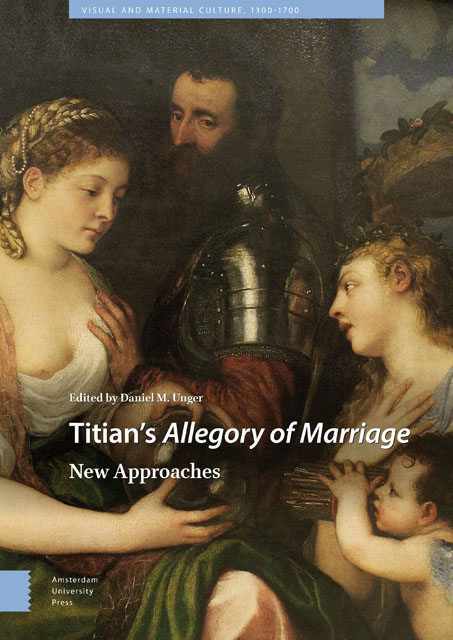Book contents
- Frontmatter
- Table of Contents
- List of Plates and Figures
- 1 Introduction: Poetic License
- 2 Love, Beauty, and the Human Body as a Reflection of the Divine
- 3 Amorosa visione: Titian’s Allegory of Marriage and the Poetry of the Half-length Format
- 4 The Arms and Armour of Titian’s Allegory of Marriage
- 5 ‘Un disio sol d’eterna gloria e fama’: A Literary Approach to Titian’s Allegory
- 6 Psyche, Venus, Ceres and Their Friends: Titian’s Remixes
- 7 Art and the Double Meaning of Reflection in Titian’s Allegory of Marriage
- 8 Titian’s Allegory of Marriage as an ‘Allegory of Peace’
- 9 Vision and Touch in the Allegory of Marriage
- 10 Of Crystal Orbs and Divinatory Mirrors : The Vicissitudes of Pregnancy and Artistic Agency in Titian’s Allegory of Marriage
- Index
6 - Psyche, Venus, Ceres and Their Friends: Titian’s Remixes
Published online by Cambridge University Press: 16 November 2022
- Frontmatter
- Table of Contents
- List of Plates and Figures
- 1 Introduction: Poetic License
- 2 Love, Beauty, and the Human Body as a Reflection of the Divine
- 3 Amorosa visione: Titian’s Allegory of Marriage and the Poetry of the Half-length Format
- 4 The Arms and Armour of Titian’s Allegory of Marriage
- 5 ‘Un disio sol d’eterna gloria e fama’: A Literary Approach to Titian’s Allegory
- 6 Psyche, Venus, Ceres and Their Friends: Titian’s Remixes
- 7 Art and the Double Meaning of Reflection in Titian’s Allegory of Marriage
- 8 Titian’s Allegory of Marriage as an ‘Allegory of Peace’
- 9 Vision and Touch in the Allegory of Marriage
- 10 Of Crystal Orbs and Divinatory Mirrors : The Vicissitudes of Pregnancy and Artistic Agency in Titian’s Allegory of Marriage
- Index
Summary
Abstract
The composition of Titian's Allegory of Marriage fused two earlier designs: his own Venus Withholding Cupid's Weapons, drawn on the original canvas, and Giulio Romano's Psyche before Proserpine. Titian reworked this fusion in a lost Psyche before Venus, probably painted in the 1530s but first documented in 1550. This much-copied picture was itself adapted, with various changes of cast and emphasis, by Titian and his studio. Towards 1560 Titian extended the composition horizontally in Venus Blindfolding Eros (Washington), now severely truncated, but whose full composition exists in the underlayers of Galleria Borghese's famous painting which, on its surface, was modified to show the Blindfolding of Cupid, not now by Venus, but by Diana, rejecting love for the hunt.
Keywords: Allegory, Diana, mythology, Psyche, Titian, Venus
Narrative and ‘realistic’ elements are not entirely suppressed in the Louvre Allegory (Plate 1) but they are minimized: Titian's pictorial choices—a format that we may justifiably call square, a predominantly profile disposition, a tightly-filled surface, a shallow depth of field, and abrupt rhythms—stress proposition above event, ideography above representation. The picture was presumably a bespoke creation, commissioned by a specific client with specific demands and designed to carry a specific if still elusive message related to sortilege and the control—or abandonment—of love. But notwithstanding the Louvre Allegory's apparently recondite nature, another version of it was laid-in by Titian or a member of his studio—but perhaps as a ‘proofing’ rather than a repetition. This painting, in the Kunsthistorisches Museum, Vienna (Figure 6.1; oil on canvas, 95 × 127 cm.), shows the same basic composition in a 1:1.25 format. It includes the seated woman, Cupid, and supplicant girl but excludes the figure at the right—presumably a satyr but not clearly recognizable as such—raising a basket.
This painting's facture does not resemble that of Padovanino, to whom it has been attributed, and an old, partial X-ray kindly shown to me by Dr. Francesca Del Torre reveals beneath the seated woman's present head an obviously Titianesque underpainting in which, paralleling the Louvre picture, her head is turned slightly outwards and her hair is enlaced with pearls.
- Type
- Chapter
- Information
- Titian's Allegory of MarriageNew Approaches, pp. 131 - 164Publisher: Amsterdam University PressPrint publication year: 2022



